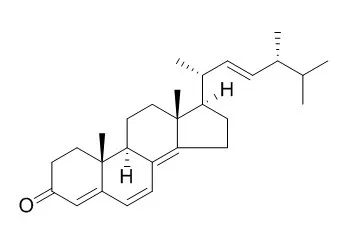| Description: |
Ergosta-4,6,8(14),22-tetraen-3-one has cytotoxic activity against human gastric cancer cell, it can induce G2/M cell cycle arrest and apoptosis in human hepatocellular carcinoma HepG2 cells, these results would be useful for the further utilization of many medicinal fungi in cancer treatment. Ergosta-4,6,8(14),22-tetraen-3-one treatment can confer protection against early renal injury in a rat model of aristolochic acid (AA) nephropathy, early administration of it may prevent the progression of renal injury and the subsequent renal fibrosis in AA nephropathy. It has inhibitory activity of nitric oxide production in RAW 264.7 cells stimulated by lipopolysaccharide was examined and shows a potential activity with the IC(50) value of 28.96 microM. |
| In vitro: |
| Biochim Biophys Acta. 2011 Apr;1810(4):384-90. | | Ergosta-4,6,8(14),22-tetraen-3-one induces G2/M cell cycle arrest and apoptosis in human hepatocellular carcinoma HepG2 cells.[Pubmed: 21241775] | Mushrooms have been used in Asia as traditional foods and medicines for a long time. Ergosta-4,6,8(14),22-tetraen-3-one (ergone) is one of the well-known bioactive steroids, which exists widely in various medicinal fungi such as Polyporus umbellatus, Russula cyanoxantha, and Cordyceps sinensis. Ergone has been demonstrated to possess cytotoxic activity. However, the molecular mechanisms by which ergone exerts its cytotoxic activity are currently unknown.
METHODS AND RESULTS:
In the present study, ergone possessed a remarkable anti-proliferative activity toward human hepatocellular carcinoma HepG2 cells. We assayed the cell cycle by flow cytometry using PI staining; investigated the exposure of phosphatidylserine at the outer layer of the cytoplasmic membrane by the FITC-annexin V/PI staining; observed the nuclear fragmentation by Hoechst 33258 staining and studied the protein expression of Bax, Bcl-2, p-53, procaspase-3, -8, -9, PARP and cleaved PARP by Western blotting analysis. Cells treated with ergone showed typical markers of apoptosis: G2/M cell cycle arrest, chromatin condensation, nuclear fragmentation, and phosphatidylserine exposure. Furthermore, PARP-cleavage; activation of caspase-3, -8, -9; up-regulation of Bax and down-regulation of Bcl-2 were observed in HepG2 cells treated with ergone, which show that both the intrinsic and extrinsic apoptotic pathways are involved in ergone-induced apoptosis in HepG2 cells. Ergosta-4,6,8(14),22-tetraen-3-one induces G2/M cell cycle arrest and apoptosis in HepG2 cells in a caspase-dependent manner.
CONCLUSIONS:
In this study, we reported for the first time that ergone-induced apoptosis through activating the caspase. These results would be useful for the further utilization of many medicinal fungi in cancer treatment. | | Nat Prod Res. 2008;22(10):901-6 | | Ergosta-4,6,8(14),22-tetraen-3-one from Vietnamese Xylaria sp. possessing inhibitory activity of nitric oxide production.[Pubmed: 18626826 ] |
METHODS AND RESULTS:
From the methanolic extract of Xylaria sp. collected in Vietnam, a fluorescent constituent, Ergosta-4,6,8(14),22-tetraen-3-one (1) was isolated and elucidated by the combination of 2D NMR, high resolution MS, IR and UV spectroscopy.
Its inhibitory activity of nitric oxide production in RAW 264.7 cells stimulated by lipopolysaccharide was examined and showed a potential activity with the IC(50) value of 28.96 microM. | | Bull. Korean Chem. Soc., 2005, 26(9):1464-6. | | Cytotoxic Activity of Ergosta-4,6,8(14),22-tetraen-3-one from the Sclerotia of Polyporus umbellatus.[Reference: WebLink] | | Cytotoxic Activity of Ergosta-4,6,8(14),22-tetraen-3-one
from the Sclerotia of Polyporus umbellatus. |
|
| In vivo: |
| J Pharm Pharmacol. 2011 Dec;63(12):1581-6. | | Ergosta-4,6,8(14),22-tetraen-3-one isolated from Polyporus umbellatus prevents early renal injury in aristolochic acid-induced nephropathy rats.[Pubmed: 22060289] | Aristolochic acid (AA) nephropathy, first reported as Chinese herbs nephropathy, is a rapidly progressive tubulointerstitial nephropathy that results in severe anemia, interstitial fibrosis and end-stage renal disease. Tubulointerstitial injury was studied in a rat model of AA nephropathy to determine whether Ergosta-4,6,8(14),22-tetraen-3-one (ergone) treatment prevents early renal injury in rats with aristolochic acid I-induced nephropathy.
METHODS AND RESULTS:
Early renal injury via renal interstitial fibrosis was induced in rats by administration of aristolochic acid I (AAI) solution intragastrically for 8 weeks. Ninety-six rats were randomly divided into four groups (n = 24/group): (1) control (2) AAI (3) AAI + ergone (10 mg/kg) and (4) AAI + ergone (20 mg/kg). Blood and urine samples were collected and rat were sacrificed for histological assessment of the kidneys on at the end of weeks 2, 4, 6 and 8. AAI caused progressive elevation of blood urea nitrogen, creatinine, potassium, sodium, chlorine, proteinuria and urinary N-acetyl-β-D-glucosaminidase (NAG). Ergone suppressed elevation of blood urea, nitrogen, creatinine, proteinuria and urinary NAG to some degree, but the AAI-ergone-treated group did not differ from AAI-treated group for body weight, serum potassium, sodium and chlorine. The progress of the lesions in the kidney after AAI administration was also observed by histopathological examinations, but kidneys from rats of AAI-ergone-treated group displayed fewer lesions.
CONCLUSIONS:
Ergone treatment conferred protection against early renal injury in a rat model of AA nephropathy. Early administration of ergone may prevent the progression of renal injury and the subsequent renal fibrosis in AA nephropathy. |
|






 Cell. 2018 Jan 11;172(1-2):249-261.e12. doi: 10.1016/j.cell.2017.12.019.IF=36.216(2019)
Cell. 2018 Jan 11;172(1-2):249-261.e12. doi: 10.1016/j.cell.2017.12.019.IF=36.216(2019) Cell Metab. 2020 Mar 3;31(3):534-548.e5. doi: 10.1016/j.cmet.2020.01.002.IF=22.415(2019)
Cell Metab. 2020 Mar 3;31(3):534-548.e5. doi: 10.1016/j.cmet.2020.01.002.IF=22.415(2019) Mol Cell. 2017 Nov 16;68(4):673-685.e6. doi: 10.1016/j.molcel.2017.10.022.IF=14.548(2019)
Mol Cell. 2017 Nov 16;68(4):673-685.e6. doi: 10.1016/j.molcel.2017.10.022.IF=14.548(2019)